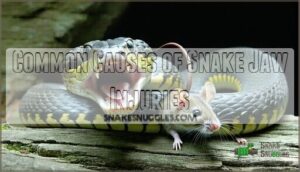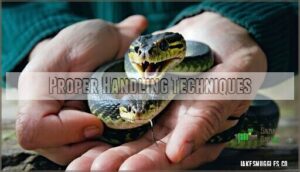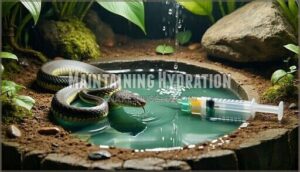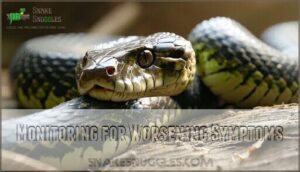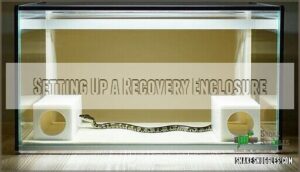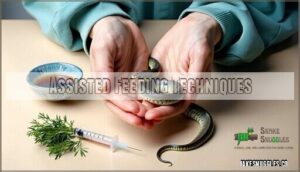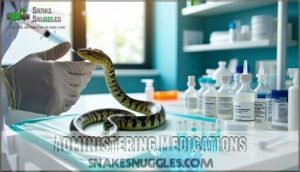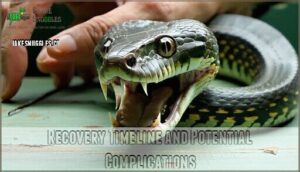This site is supported by our readers. We may earn a commission, at no cost to you, if you purchase through links.
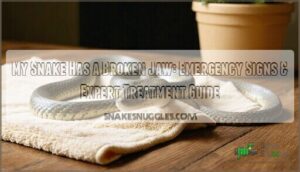
This isn’t something you can fix with a YouTube tutorial—your scaly friend needs professional help immediately.
Create a quiet, warm environment and avoid handling unless necessary.
Don’t attempt feeding, as this could worsen the injury.
Transport your snake to an exotic veterinarian in a secure, ventilated container.
Treatment typically involves pain medication, antibiotics, and sometimes splinting or surgery.
While jaw injuries sound scary, many snakes recover well with proper care.
The key lies in recognizing subtle warning signs before things get worse.
Table Of Contents
- Key Takeaways
- Identifying Signs of a Broken Snake Jaw
- Common Causes of Snake Jaw Injuries
- Immediate First Aid for a Broken Snake Jaw
- Veterinary Diagnosis and Treatment Options
- Home Care for a Snake With Jaw Injury
- Recovery Timeline and Potential Complications
- Preventing Future Snake Jaw Injuries
- When to Consider Euthanasia for Severe Cases
- Frequently Asked Questions (FAQs)
- Can a snake eat a broken jaw?
- Can snakes break their jaws?
- What should I do if my snake has a broken jaw?
- Why do snakes have hinged jaws?
- Can snakes unhinge their jaws?
- Why do Snakes yawn a lot?
- Can a snake survive with a broken jaw?
- Do snakes have a split jaw?
- How do I know if my snakes’ jaw is broken?
- Can a snake dislocate their jaw?
- Conclusion
Key Takeaways
- Seek immediate veterinary care – Don’t attempt DIY fixes, as jaw injuries require professional X-rays, pain medication, and potentially surgery or splinting for proper healing.
- Watch for key warning signs – You’ll notice visible jaw misalignment, difficulty eating, mouth gaping, swelling, bleeding, or behavioral changes that signal a broken jaw.
- Create a recovery environment – Keep your snake in a quiet, warm space with no decorations, avoid handling, and don’t attempt feeding until cleared by your vet.
- Prevent future injuries – Choose appropriately-sized prey (no wider than your snake’s thickest body section) and maintain proper enclosure safety to avoid repeat trauma.
Identifying Signs of a Broken Snake Jaw
Recognizing a broken snake jaw requires careful observation of specific physical and behavioral changes that indicate trauma to your pet’s delicate jaw structure.
You’ll need to act quickly when you spot these warning signs, as jaw injuries can rapidly lead to serious complications including infection, malnutrition, and long-term feeding difficulties, which can be exacerbated by the initial trauma.
Visible Jaw Misalignment
Spotting jaw misalignment requires careful observation of your snake’s head positioning. When snake anatomy goes awry, jaw alignment becomes obviously skewed—one side may droop lower or appear twisted compared to normal positioning.
Key misalignment indicators to watch for:
- Upper and lower jaw sections don’t meet properly
- One jaw side sits noticeably higher than the other
- Visible gaps between jaw bones when mouth closes
- Crooked or twisted jaw appearance from any angle
- Asymmetrical facial structure compared to baseline normal
These injury signs often indicate jaw fracture or dislocation requiring immediate veterinary attention.
Difficulty Eating or Swallowing
Beyond visible misalignment, feeding issues reveal jaw problems.
When jaw dislocation occurs, you’ll notice distinct swallowing problems and eating difficulties:
- Refusing food outright – Your snake won’t strike at prey
- Dropping prey mid-swallow – Starting to eat but can’t finish
- Unusual head tilting – Compensating for jaw alignment issues
- Regurgitating meals – Digestive struggles from incomplete swallowing
These snake feeding issues indicate serious jaw problems requiring immediate veterinary attention.
Swelling Around The Jaw Area
Recognizing snake jaw swelling requires careful observation of your pet’s facial structure.
Inflammation signs around the jawline often indicate jaw trauma or underlying jaw infection.
You’ll notice puffiness that makes your snake’s head appear lopsided or unusually thick.
Swelling causes can range from bacterial infections to physical injury.
This visible inflammation typically accompanies other symptoms, making early detection essential for effective pain management and treatment.
Unusual Mouth Gaping or Positioning
A snake jaw injury can leave your pet’s mouth hanging open like a broken door.
You’ll spot jaw asymmetry where one side droops lower than the other, creating obvious facial deformity.
Mouth locking occurs when your snake can’t close its jaw properly, while gaping issues make the mouth appear frozen in an unnatural position.
This jaw malformation signals potential jaw dislocation requiring immediate attention.
Bleeding From The Mouth
Any sign of bleeding from your snake’s mouth signals potential mouth trauma or jaw infection requiring immediate attention.
Fresh blood, blood-tinged saliva, or dark discharge can indicate serious oral wounds or developing mouth rot.
- Bright red blood – Active bleeding from recent jaw injury or gum damage
- Dark, clotted blood – Indicates older trauma or internal oral bleeding
- Blood-tinged saliva – Early warning sign of jaw problems or infection
Changes in Behavior or Activity Level
While blood in the mouth signals immediate danger, behavior changes and lethargy signs often appear first.
Your snake might suddenly become withdrawn, hiding more than usual, or showing feeding changes like refusing meals.
Stress factors from jaw pain create noticeable shifts in activity levels.
| Normal Behavior | Injury Indicators |
|---|---|
| Active exploration | Excessive hiding |
| Regular feeding | Difficulty eating |
| Calm handling | Defensive posturing |
| Normal positioning | Head tilting |
| Social interaction | Lack of appetite |
Common Causes of Snake Jaw Injuries
Understanding what causes snake jaw injuries helps you protect your pet from preventable trauma.
Most jaw breaks happen when snakes try to swallow prey that’s too large for their mouth, or when underlying health problems weaken their bone structure.
Prey Size Complications
When you offer prey too large for your snake’s mouth, you’re asking for trouble.
Prey sizing directly affects jaw dislocation risk – meals exceeding 1.5 times your snake’s head width can overstretch jaw ligaments.
Poor prey selection accounts for nearly half of feeding-related injuries.
Smart feeding techniques prevent snake jaw problems before they start.
Understanding snake jaw anatomy is essential to avoiding these issues.
Underlying Health Factors
Beyond oversized meals, your snake’s jaw weakness might stem from hidden health problems.
These conditions make bones brittle and prone to fractures during normal activities:
- Metabolic Issues from calcium imbalances weakening jaw structure
- Vitamin Deficiencies (especially D3) causing bone softening
- Infections like septicemia compromising tissue integrity
- Parasites draining nutrients needed for bone health
- Genetic Predisposition creating structural vulnerabilities from birth
Regular monitoring of a snake’s health is essential to identify common snake health issues early on.
Immediate First Aid for a Broken Snake Jaw
When you discover your snake has a broken jaw, quick action can mean the difference between recovery and serious complications.
Time is critical when your snake’s jaw breaks—every minute counts for successful recovery.
Your first priority is stabilizing your pet while preparing for emergency veterinary care.
Creating a Safe, Stress-free Environment
Your snake’s recovery sanctuary needs careful setup.
Dim the lights to reduce stress and create a calm healing environment.
Remove decorative items that could cause additional injury.
Maintain proper temperature control between 75-85°F to support natural healing processes.
Provide a secure hide box for comfort.
These calming techniques transform any enclosure into a therapeutic recovery space.
Ensuring the right reptile heat sources is essential for a stable environment.
Proper Handling Techniques
When handling your injured snake, use gentle restraint techniques like you’re cradling a delicate sculpture.
Support the body with both hands, avoiding direct jaw contact. Move slowly and speak softly—stressed snakes heal poorly.
Keep handling sessions brief for injury prevention.
Proper snake handling techniques reduce further trauma while ensuring safe transport to your veterinarian.
Maintaining Hydration
After securing your snake, hydration becomes your next priority. Jaw injuries often prevent normal water intake, making dehydration a serious concern during snake recovery.
- Water Intake: Place shallow dishes throughout the enclosure, allowing easy access without drowning risk
- Humidity Control: Maintain 60-70% moisture levels through regular misting and damp substrate
- Fluid Therapy: Administer oral hydration using a syringe if your snake can’t drink independently
- Hydration Methods: Provide 10-minute lukewarm soaks every few hours for severely dehydrated snakes
For effective rehydration, consider using a rehydration method to help your snake recover from dehydration.
Monitoring for Worsening Symptoms
Several critical red flags demand immediate attention when monitoring your snake’s jaw injury.
Watch for increased jaw swelling, worsening feeding issues, or escalating pain levels.
Any breathing difficulties, excessive drooling, or declining mobility signals deteriorating snake jaw health.
Symptom tracking helps gauge healing progress – note changes in appetite, mouth positioning, and overall behavior daily.
Preparing for Veterinary Transport
After monitoring your snake’s symptoms, you’ll need to prepare for safe transport to the veterinary clinic.
Getting your injured snake to the reptile vet requires careful planning and gentle handling techniques.
- Secure a proper transport container – Use a well-ventilated carrier or sturdy box with secure latches
- Pack your emergency kit – Include medical records, recent photos of the snake jaw injury, and any medications
- Handle with extra care – Support the snake’s body fully to prevent further snake jaw fracture complications
- Call ahead for veterinary prep – Alert the clinic about your snake’s condition for immediate veterinary care
Veterinary Diagnosis and Treatment Options
Once your vet confirms the diagnosis through X-rays, they’ll create a treatment plan that might include splinting, surgery, or medication depending on the severity.
Professional veterinary care is essential since snake jaw injuries can quickly become life-threatening without proper intervention.
X-rays and Imaging Techniques
Your veterinarian will use diagnostic tools like X-rays and CT scans to reveal hidden snake jaw fractures.
These medical imaging techniques provide crystal-clear views of bone alignment and damage severity.
Radiography helps determine if your snake needs simple stabilization or complex snake jaw repair.
Trust these veterinary services – proper jaw imaging guides effective treatment decisions.
Splinting Procedures
After imaging confirms the fracture location, your veterinarian will likely recommend jaw splinting for snake jaw repair.
External coaptation using custom-shaped wire frames provides effective jaw stabilization without invasive procedures.
Splint Materials and Application:
- Wire Framework – Molded paper clips or specialized wire create the structural base for fracture repair
- Dental Acrylic Bonding – Non-toxic compounds secure the splint while allowing natural shedding cycles
- Adhesive Reinforcement – Medical tape prevents premature detachment during jaw movement
The splinting process requires anesthesia for precise bone realignment.
Your vet shapes the wire frame to match your snake’s jaw curvature, then applies dental acrylic over the exterior skin.
This surgical technique distributes healing forces evenly across the fracture site while maintaining jaw function for assisted feeding.
Surgical Interventions
When your snake needs jaw surgery, it’s serious business, but skilled reptile vets can work miracles.
They’ll evaluate fracture severity and your pet’s overall health before recommending surgical stabilization or bone grafting procedures.
| Surgical Option | Best For |
|---|---|
| Wire Fixation | Simple fractures |
| Pin Placement | Complex breaks |
| Bone Grafting | Severe tissue loss |
Surgery isn’t always necessary, but when conservative treatments fail, these surgical interventions can restore normal jaw function and get your slithery friend back to swallowing whole meals again.
Pain Management and Antibiotics
After surgical repair, your snake needs pain management and antibiotic treatment.
Vets prescribe specific pain relief medications and targeted antibiotics for infection control. They’ll calculate exact dosages based on your snake’s weight and species.
Medication safety is paramount – never use human medications.
Proper wound care and antibiotic use prevent complications during jaw injury treatment, ensuring your pet’s comfort throughout recovery.
Effective pain relief options(safe pain relief) are essential for a successful recovery process.
Nutritional Support Methods
How do you keep your snake nourished when eating becomes impossible?
Nutritional support methods facilitate recovery through specialized feeding techniques:
- Liquid diets delivered via tube feeding directly to the stomach
- Food supplements mixed with blended prey for enhanced nutrition
- Dietary adjustments using soft, easily digestible prey items
- Nutrient therapy with commercial carnivore formulas
- Assisted feeding techniques minimizing stress during recovery
Your vet will customize the approach based on injury severity and your snake’s tolerance.
Home Care for a Snake With Jaw Injury
Once your vet confirms the diagnosis and treatment plan, you’ll become your snake’s primary caregiver during recovery.
Creating the right home environment and following proper care protocols can mean the difference between successful healing and serious complications.
Setting Up a Recovery Enclosure
Creating the perfect recovery enclosure transforms your snake’s healing journey.
Choose a smaller, secure container that prevents excessive movement while maintaining comfort.
Select paper towels or reptile carpet as substrate—easy to clean and monitor for blood or discharge.
Remove decorations, water bowls, and climbing branches that could cause reinjury.
Position hide boxes at both ends for security.
This simplified enclosure design prioritizes snake jaw injury treatment success over aesthetics.
Proper reptile enclosures require careful planning and equipment, including suitable reptile enclosure materials to guarantee the snake’s safety and recovery.
Temperature and Humidity Control
Your snake’s recovery depends on precise temperature regulation and humidity levels.
Maintain thermal gradients between 75-85°F with consistent heat sources—no wild temperature fluctuations that stress healing tissues.
Control moisture at species-appropriate levels using reliable monitoring.
Stable snake environment conditions boost immune function and tissue repair.
Think of it as creating a healing spa for your scaly patient.
Assisted Feeding Techniques
Your injured snake needs special feeding care while healing.
Use syringe feeding with liquid diets or blended prey for easier swallowing. Tube feeding may be necessary for severe cases – let your vet show you proper technique.
Feeding tools like soft-tipped syringes work best. Add food supplements to maintain nutrition during assisted feeding recovery.
For proper nutrition, consider proper prey selection guidelines to guarantee your snake receives a balanced diet.
Administering Medications
Your snake’s recovery depends on proper medication administration. Getting the dosage right isn’t just about following orders—it’s about healing that jaw safely.
- Pain Relief: Administer prescribed pain medication exactly as directed, never skipping doses
- Medication Dosage: Use syringes or droppers for precise measurements, especially with liquid antibiotics
- Injection Techniques: Let your vet handle injectable medications unless you’re trained in proper technique
- Oral Administration: Mix liquid meds with food when possible, or use gentle syringe feeding for direct delivery
Monitoring Healing Progress
Tracking your snake’s jaw recovery feels like watching grass grow – patience pays off.
Document healing stages daily through photos and notes.
| Recovery Milestone | Timeline |
|---|---|
| Initial swelling reduction | 7-14 days |
| Jaw alignment improvement | 2-4 weeks |
| Return of feeding interest | 3-6 weeks |
| Full recovery time | 2-4 months |
| Complete healing confirmation | 4-6 months |
Monitor symptoms like appetite changes, mouth positioning, and swelling.
Consistent progress tracking helps identify setbacks early.
Your snake’s jaw recovery depends on careful observation and wound care maintenance.
Preventing Further Injury
Once you’ve stabilized your snake’s broken jaw, preventing further damage becomes your top priority.
Think of your injured snake as a fragile patient who needs extra TLC during recovery.
Key injury prevention strategies:
- Enclosure Safety: Remove sharp decorations, rough substrates, and climbing hazards that could cause re-injury
- Gentle Care: Handle minimally using proper jaw support techniques – support the head and neck area during necessary moves
- Safe Handling: Use slow, deliberate movements and avoid sudden motions that might startle your snake
- Injury Prevention: Monitor feeding closely, offering appropriately-sized prey to prevent jaw strain during healing
Recovery Timeline and Potential Complications
Understanding your snake’s recovery journey helps you provide the best care possible. The healing process varies substantially based on injury severity, your snake’s overall health, and how quickly treatment begins.
Expected Healing Stages
Recovery follows predictable healing timeline stages.
Initial inflammation peaks within 48-72 hours, causing swelling and discomfort.
Bone regeneration begins week two, with callus formation around fracture sites.
Tissue repair accelerates during weeks 3-6 as new bone matrix develops.
The scarring process continues for months, though your snake’s appetite typically returns gradually.
Snake jaw healing varies by injury severity, but most see improvement within 4-8 weeks with proper snake jaw injury treatment.
Signs of Proper Healing
Several key indicators show your snake’s jaw is healing properly.
Jaw alignment improves gradually as tissue regeneration occurs.
You’ll notice swelling reduction around the injury site, typically within two weeks.
Your snake’s appetite returns slowly—this feeding recovery signals positive healing progress.
Watch for decreased drooling and improved mouth closure.
The snake becomes more active and alert as healing time progresses, showing less defensive behavior during routine monitoring symptoms checks.
Possible Long-term Effects
While recovery looks promising, snake jaw injury complications can create lasting challenges.
Your pet may experience permanent damage affecting daily life substantially.
- Jaw Mobility: Reduced opening range limits prey size options permanently
- Dietary Limits: Scarring effects restrict feeding to smaller food items only
- Permanent Damage: Malunion causes chronic misalignment affecting jaw function long-term
- Reduced Survival: Compromised jaw fracture healing impacts hunting abilities in wild scenarios
Recognizing Infection or Setbacks
Watch for infection signs that spell trouble for your snake’s healing jaw.
Post surgery complications include increased jaw swelling, foul-smelling discharge, and pus around wound sites.
Snake jaw infection appears as red, inflamed tissue with abnormal bleeding.
Your pet might refuse food or show healing delays beyond normal recovery time.
If jaw fracture areas feel warmer than usual or bleeding persists, contact your vet immediately.
Snake health issues can escalate quickly without proper wound care, and it is crucial to monitor for signs of infection, such as foul-smelling discharge, and take immediate action to prevent complications, including abnormal bleeding.
Follow-up Veterinary Care
Follow-up veterinary visits aren’t just paperwork—they’re your snake’s lifeline to full recovery.
Your reptile vet will schedule regular follow up exams to assess jaw rehabilitation progress, adjust medication management, and catch complications early.
These post surgery care appointments guarantee proper healing and prevent setbacks in your snake’s jaw injury treatment journey.
Preventing Future Snake Jaw Injuries
Once you’ve treated your snake’s jaw injury, you’ll want to make sure it never happens again.
Prevention involves creating a safe environment, choosing appropriate prey sizes, and maintaining regular health monitoring to catch potential issues before they become serious problems.
Proper Enclosure Design
Your snake’s enclosure size matters—cramped quarters increase injury risk.
Use PVC or wooden tanks with secure latches, not glass. Choose flat substrates like paper towels for easy snake sanitation.
Remove climbing structures and sharp edges. Maintain proper temperature gradients and humidity control with under-tank heaters.
Make certain adequate ventilation systems are in place without screen tops that cause facial injuries. Properly designed PVC snake tanks can help prevent future injuries by providing a safe and healthy environment.
Safe Handling Practices
Proper gentle handling prevents jaw trauma before it starts.
Support your snake’s entire body when lifting—never grab just the head or tail.
Use slow, deliberate movements during safe transport to minimize stress reduction.
Allow your snake to move naturally through your hands rather than restraining it tightly.
These handling techniques create a safe environment that protects against injury prevention while maintaining trust between you and your reptile.
Appropriate Prey Size Selection
Since prey size complications rank among leading causes of snake jaw injuries, selecting appropriate food becomes your first line of defense against jaw dislocation. Think of it like choosing shoes – too big creates problems!
- Prey Size Limits: Choose prey no wider than your snake’s thickest body section
- Feeding Guidelines: Young snakes need smaller, more frequent meals than adults
- Snake Nutrition: Varied prey species prevent nutritional deficiencies that weaken jaw bones
Regular Health Check-ups
Prevention beats treatment every time.
Schedule annual veterinary care with a reptile specialist for thorough health screening.
During these visits, your vet performs thorough jaw inspection and snake examination, catching potential issues before they become emergencies.
These preventive measures guarantee your snake’s long-term reptile health and help avoid costly snake jaw injury complications down the road.
Addressing Underlying Health Issues
With proper diagnostic care, you’ll identify metabolic issues and vitamin deficiencies that weaken jaw structure.
Address genetic predisposition through targeted nutritional therapy and thorough infection control protocols.
Think of it as building your snake’s foundation from the ground up—preventing snake jaw injury requires tackling root causes like snake malnutrition and systemic reptile health problems before they manifest as serious jaw infections.
Regular preventative health care reptile health checks can help identify these issues early on.
When to Consider Euthanasia for Severe Cases
Sometimes you’ll face the hardest decision any snake owner can make – whether your pet’s suffering outweighs their ability to live comfortably.
When severe jaw fractures cause chronic pain, prevent eating entirely, or create ongoing health complications that don’t respond to treatment, euthanasia might be the most compassionate choice.
Assessing Quality of Life
When your snake’s broken jaw becomes a chronic problem, you need to honestly evaluate their quality of life.
Pain Assessment becomes the foundation of this difficult decision, as chronic discomfort affects every aspect of their existence.
Consider these key factors:
- Feeding Independence – Can they consume prey without constant assistance?
- Pain Management – Are medications effectively controlling their discomfort?
- Natural Behaviors – Do they still exhibit normal snake activities like exploring and basking?
Life Expectancy with severe snake jaw injury often involves permanent limitations.
The Emotional Toll on both you and your pet matters when considering Care Options versus Euthanasia Considerations for their snake jaw health.
Consulting With a Reptile Veterinarian
Finding the right reptile veterinarian can feel overwhelming during a crisis.
Start by locating emergency vets experienced with snake jaw injuries through online directories or local reptile groups.
Be upfront about your snake’s condition and ask about their experience with similar cases, and discuss cost considerations upfront, as specialized reptile care can be expensive.
Don’t hesitate to seek second opinions for complex decisions.
Understanding The Euthanasia Process
When euthanasia becomes necessary for severe snake jaw injury, your veterinarian will explain available humane options.
Most reptile vets use sedation followed by barbiturate injection – it’s peaceful and painless.
The process takes minutes, not hours, and you’ll discuss timing, location preferences, and aftercare arrangements beforehand.
Quality assessment guides these difficult veterinary care decisions for your snake’s wellbeing.
Coping With The Decision
Making the difficult choice to end your snake’s suffering requires incredible strength, and you shouldn’t face this emotional burden alone.
Sometimes the hardest choices show the deepest love for our scaly companions.
- Owner Guilt is normal – remember you’re choosing compassion over prolonging pain
- Emotional Support from family, friends, or online reptile communities helps process grief
- Grief Counseling services specialize in pet loss and Decision Making around Pet Euthanasia
- Veterinary Care teams understand your bond and can guide you through this process
These resources are available to support you during this challenging time.
Alternative Options to Consider
Hope isn’t lost when facing severe snake jaw injuries.
Before considering euthanasia, explore alternative snake jaw care options with veterinary help.
Physiotherapy can improve mobility, while acupuncture and herbal remedies may reduce pain.
Some reptile specialists offer homeopathy or aromatherapy for comfort.
These alternative options might extend your snake’s quality life substantially.
Frequently Asked Questions (FAQs)
Can a snake eat a broken jaw?
No, snakes can’t eat with a broken jaw. You’ll need immediate veterinary care since jaw injuries prevent normal feeding, causing serious complications like malnutrition and infection without proper treatment.
Can snakes break their jaws?
Absolutely devastating news – yes, your snake can break their jaw through trauma, oversized prey, or improper handling.
These injuries cause feeding difficulties, pain, and require immediate veterinary care with potential surgical intervention for proper healing.
What should I do if my snake has a broken jaw?
Immediately contact an exotic veterinarian for emergency care.
Don’t attempt feeding or handling.
Keep your snake calm, hydrated, and warm.
Professional diagnosis with X-rays and surgical stabilization may be necessary for proper healing.
Why do snakes have hinged jaws?
Like a zipper that can open incredibly wide to fit bulky items, your snake’s hinged jaw structure lets them swallow prey much larger than their head.
Through multiple joint points and stretchy ligaments connecting jaw bones, this unique feature enables the snake to consume a wide range of prey sizes.
Can snakes unhinge their jaws?
Actually, snakes don’t unhinge their jaws like many people think.
Instead, they’ve got incredibly flexible jaw joints and stretchy ligaments that let them open their mouths super wide to swallow large prey whole.
Why do Snakes yawn a lot?
Your serpent’s seemingly sleepy stretches aren’t yawns—they’re realigning their jaw joints after meals.
You’ll notice this stretching behavior helps reset their flexible jaw structure, especially following feeding sessions or when they’re preparing to shed their skin, which is a critical aspect of their skin preparation.
Can a snake survive with a broken jaw?
Yes, snakes can survive broken jaws with proper veterinary care.
They’ll need pain medication, antibiotics, and assisted feeding.
Healing takes 6 weeks to 6 months, though the jaw remains permanently weakened and more injury-prone afterward, requiring careful management to prevent further injury.
Do snakes have a split jaw?
Yes, snakes have split jaws.
The lower jaw consists of two separate pieces connected by stretchy ligaments, not fused bone.
This allows each side to move independently when swallowing large prey whole.
How do I know if my snakes’ jaw is broken?
Don’t judge a book by its cover—jaw injuries aren’t always obvious.
Watch for visible misalignment, difficulty eating, mouth stuck open, swelling around jawline, or bleeding from mouth.
Immediate veterinary assessment is vital.
Can a snake dislocate their jaw?
Snakes don’t actually dislocate their jaws.
Instead, they’ve got incredibly flexible jaw joints and stretchy ligaments that let them open their mouths super wide—think of it like having double-jointed thumbs, but for eating.
Conclusion
Picture a knight in shining scales, battered but not broken.
When your snake has a broken jaw, you’ve become their guardian through a challenging quest.
Early recognition and swift veterinary action make the difference between a full recovery and lasting complications.
Don’t underestimate your snake’s resilience—they’re tougher than they look.
With proper medical care, patience, and your dedication to their healing journey, most jaw injuries heal completely.
Trust the process and your exotic vet’s expertise.
- https://www.avma.org/resources/pet-owners/petcare/snake-care
- https://www.reptileknowledge.com/reptile-pedia/how-does-a-snakes-jaw-help-it-survive
- https://vcahospitals.com/know-your-pet/snakes-diseases
- https://www.petmd.com/reptile/care/evr_rp_how-can-i-tell-if-my-snake-sick
- https://www.petcoach.co/article/egg-binding-dystocia-in-reptiles-causes-signs-diagnosis-tre/

